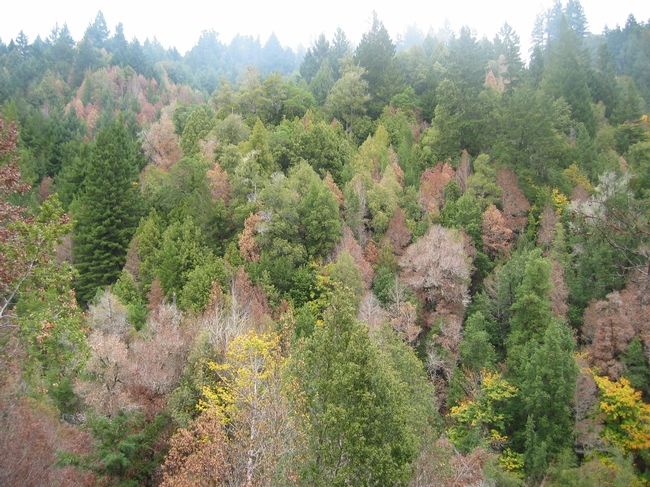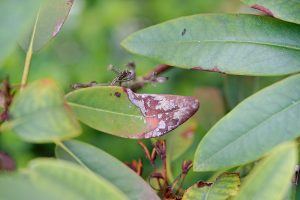Sudden Oak Death (SOD) is estimated to have already killed over a million oak and tanoak trees in California and Oregon. The name may be a bit misleading, because Sudden Oak Death can actually affect many plant species, making it a dire threat to all of Sonoma County’s woodlands.
Our forests are filled with trees in the oak family such as Tanoaks and Coast Live Oaks, all of which are incredibly susceptible to the phytophthora ramorum pathogen that causes Sudden Oak Death.
Phytophthora Ramorum in Sonoma County
Phytophthora Ramorum (P. ramorum) is a water mold pathogen that can infect more than 150 species of plants on earth, and more than 45 tree and shrub species specifically in California. The P. ramorum pathogen can spread to new plant hosts by the wind, rain, or through contaminated soil. This deadly pathogen thrives in cool, wet, climates making California’s foggy woodlands an ideal habitat for P. ramorum to thrive.
The Impact of Sudden Oak Death on Sonoma County
1. Environmental Impact: Increased Susceptibility to Wildfires
Sonoma County residents are already very familiar with the threat wildfires have on our community. If more trees remain untreated and are lost due to Sudden Oak Death, our landscape will only continue to become more susceptible to wildfire.
Removing dead trees is essential to improving the wildfire defensible space around your home. The experts at Vintage Tree Care can help you assess and help you address any areas around your property that may be vulnerable to wildfires.
2. Ecological Impact: Loss of Indigenous Land and Wildlife Preservation
The loss of Tanoak and Oak trees due to the spread of this deadly pathogen can result in a huge decrease in our local natural habitat. This directly affects the native wildlife populations that rely on these tree species for food and shelter. This loss has also greatly impacted many indigenous Northern California communities that revere the tanoak acorn as traditional ceremonial food.
3. Economic Impact: Lower Property Value and Loss of Horticultural Revenue
Planting trees on your property is one of the easiest ways to boost your curb appeal and increase the value of your home. Oak trees in particular are wonderful additions that can greatly raise the value of the real estate they inhabit. Trees afflicted by SOD that are not properly cared for or left to die will instantly lower your property value.
Additionally, several horticultural industries in California have suffered extensively due to the unmanaged spread of Sudden Oak Death. Many plant nurseries, and the spice and composting industries have already suffered a devastating hit.
How to Spot the Symptoms of Sudden Oak Death
Depending on the type of plant species it infects, the Phytophthora Ramorum water mold can cause different symptoms in host plants and trees. It’s also important to note that not all plants will die from an infection, but rather host the P. ramorum pathogen and allow it to produce more spores and spread.
Sudden Oak Death Symptoms
When the P. ramorum pathogen infects a member of the oak tree family such as Coast Live Oaks or Tanoak tree, it causes lethal cankers to develop on the trunks. Oftentimes these bark cankers will appear to bleed red or black sap, which is what arborists refer to as Sudden Oak Death (SOD). In parts of Europe, the fungus-like mold has been found in Japanese Larch trees resulting in the same lethal cancers and causing Sudden Larch Death (SLD).
Ramorum Leaf Blight and Shoot Dieback Symptoms
If a tree canopy is infected you will commonly see symptoms on the foliage including discoloration, stem lesions, and dieback. When the Phytophthora Ramorum pathogen inhabits larger vegetation like native trees its spores can easily migrate to lower herbs, shrubs, and other plant species. Lower-level vegetation will usually present with irregularly shaped leaves and dark lesions. After the plant dies and decomposes, the P. ramorum spores are absorbed into the soil, where it can survive without a plant host for an unclear amount of time.
How to Prevent the Spread of Sudden Oak Death in Sonoma County
Unfortunately, there is no cure for Sudden Oak Death, making preventive tree care and early detection essential to manage the spread of this devastating disease in Sonoma County. Contact the certified arborists at Vintage Tree Care to learn more about identifying, diagnosing, and controlling the spread of SOD.
Contact Vintage Tree Care to Help Stop Sudden Oak Death in Sonoma County
The dangers of Sudden Oak Death in Sonoma County are not to be taken lightly. It is essential for all Sonoma County residents to contact a professional arborist if they believe a tree on their property may be suffering from Sudden Oak Death.
Vintage Tree Care has been serving Sonoma County for over 25 years, and our certified arborists are dedicated to keeping our community safe and beautiful for years to come. Contact our team today to request an Estimate for services, or to schedule a professional tree inspection.




